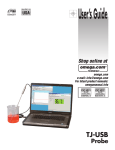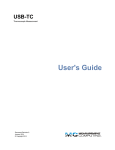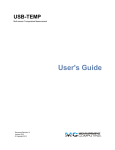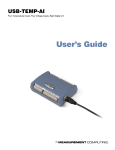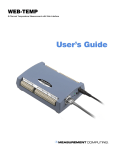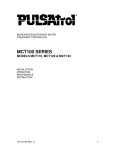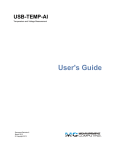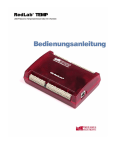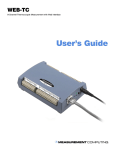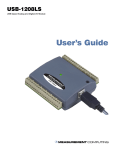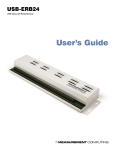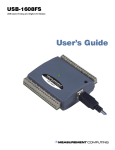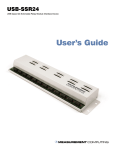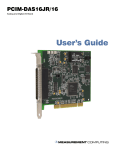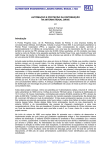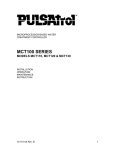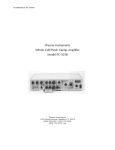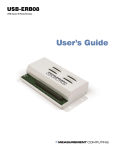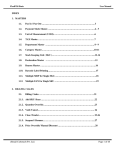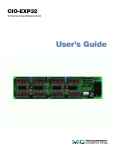Download User`s Manual
Transcript
USB-TEMP USB-based High-Precision 8-Channel Temperature Measurement Module User's Guide Document Revision 9, October, 2006 © Copyright 2006, Measurement Computing Corporation Your new Measurement Computing product comes with a fantastic extra — Management committed to your satisfaction! Refer to www.mccdaq.com/execteam.html for the names, titles, and contact information of each key executive at Measurement Computing. Thank you for choosing a Measurement Computing product—and congratulations! You own the finest, and you can now enjoy the protection of the most comprehensive warranties and unmatched phone tech support. It’s the embodiment of our mission: To provide PC-based data acquisition hardware and software that will save time and save money. Simple installations minimize the time between setting up your system and actually making measurements. We offer quick and simple access to outstanding live FREE technical support to help integrate MCC products into a DAQ system. Lifetime warranty: Every hardware product manufactured by Measurement Computing Corporation is warranted against defects in materials or workmanship for the life of the product. Products found defective are repaired or replaced promptly. Lifetime Harsh Environment Warranty®: We will replace any product manufactured by Measurement Computing Corporation that is damaged (even due to misuse) for only 50% of the current list price. I/O boards face some tough operating conditions, some more severe than the boards are designed to withstand. When a board becomes damaged, just return the unit with an order for its replacement at only 50% of the current list price. We don’t need to profit from your misfortune. By the way, we honor this warranty for any manufacturer’s board that we have a replacement for. 30 Day Money Back Guarantee: You may return any Measurement Computing Corporation product within 30 days of purchase for a full refund of the price paid for the product being returned. If you are not satisfied, or chose the wrong product by mistake, you do not have to keep it. Please call for an RMA number first. No credits or returns accepted without a copy of the original invoice. Some software products are subject to a repackaging fee. These warranties are in lieu of all other warranties, expressed or implied, including any implied warranty of merchantability or fitness for a particular application. The remedies provided herein are the buyer’s sole and exclusive remedies. Neither Measurement Computing Corporation, nor its employees shall be liable for any direct or indirect, special, incidental or consequential damage arising from the use of its products, even if Measurement Computing Corporation has been notified in advance of the possibility of such damages. HM PMD-Temp.doc 3 Trademark and Copyright Information TracerDAQ, Universal Library, Harsh Environment Warranty, Measurement Computing Corporation, and the Measurement Computing logo are either trademarks or registered trademarks of Measurement Computing Corporation. Windows, Microsoft, and Visual Studio are either trademarks or registered trademarks of Microsoft Corporation LabVIEW is a trademark of National Instruments. CompactFlash is a registered trademark of SanDisk Corporation. XBee is a trademark of MaxStream, Inc. All other trademarks are the property of their respective owners. Information furnished by Measurement Computing Corporation is believed to be accurate and reliable. However, no responsibility is assumed by Measurement Computing Corporation neither for its use; nor for any infringements of patents or other rights of third parties, which may result from its use. No license is granted by implication or otherwise under any patent or copyrights of Measurement Computing Corporation. All rights reserved. No part of this publication may be reproduced, stored in a retrieval system, or transmitted, in any form by any means, electronic, mechanical, by photocopying, recording, or otherwise without the prior written permission of Measurement Computing Corporation. Notice Measurement Computing Corporation does not authorize any Measurement Computing Corporation product for use in life support systems and/or devices without prior written consent from Measurement Computing Corporation. Life support devices/systems are devices or systems which, a) are intended for surgical implantation into the body, or b) support or sustain life and whose failure to perform can be reasonably expected to result in injury. Measurement Computing Corporation products are not designed with the components required, and are not subject to the testing required to ensure a level of reliability suitable for the treatment and diagnosis of people. 4 Table of Contents Preface About this User’s Guide .......................................................................................................................7 What you will learn from this user’s guide.........................................................................................................7 Conventions in this user’s guide.........................................................................................................................7 Where to find more information .........................................................................................................................7 Chapter 1 Introducing the USB-TEMP ..................................................................................................................8 Overview: USB-TEMP features .........................................................................................................................8 USB-TEMP block diagram.................................................................................................................................9 Software features ................................................................................................................................................9 Connecting a USB-TEMP to your computer is easy ........................................................................................10 Chapter 2 Installing the USB-TEMP ....................................................................................................................11 What comes with your USB-TEMP shipment? ................................................................................................11 Hardware .........................................................................................................................................................................11 Additional documentation................................................................................................................................................11 Unpacking the USB-TEMP ..............................................................................................................................11 Installing the software ......................................................................................................................................12 Installing the USB-TEMP.................................................................................................................................12 Configuring the USB-TEMP ............................................................................................................................12 Calibrating the USB-TEMP..............................................................................................................................12 Chapter 3 Sensor Connections ...........................................................................................................................13 Screw terminal pin out......................................................................................................................................13 Sensor input terminals (C0H/C0L to C7H/C7L)..............................................................................................................14 Current excitation output terminals (±I1 to ±I4) ..............................................................................................................15 Four-wire, two sensor common terminals (4W01 to 4W67)............................................................................................15 Two sensor common terminals (IC01 to IC67)................................................................................................................15 Ground terminals (GND) .................................................................................................................................................15 Power terminals (+5V).....................................................................................................................................................15 Digital terminals (DIO0 to DIO7)....................................................................................................................................15 CJC sensors......................................................................................................................................................................15 Thermocouple connections...............................................................................................................................15 Wiring configuration........................................................................................................................................................16 RTD and thermistor connections ......................................................................................................................16 Two-wire configuration ...................................................................................................................................................17 Three-wire configuration .................................................................................................................................................18 Four-wire configuration ...................................................................................................................................................18 Semiconductor sensor measurements ...............................................................................................................19 Wiring configuration........................................................................................................................................................19 Digital I/O connections.....................................................................................................................................20 Chapter 4 Functional Details ...............................................................................................................................21 Thermocouple measurements ...........................................................................................................................21 Cold junction compensation (CJC) ..................................................................................................................................21 Data linearization.............................................................................................................................................................21 Open-thermocouple detection (OTD) ..............................................................................................................................21 RTD and thermistor measurements ..................................................................................................................22 Data linearization.............................................................................................................................................................22 USB connector..................................................................................................................................................22 5 USB-TEMP User's Guide LED ..................................................................................................................................................................22 Power................................................................................................................................................................22 Chapter 5 Specifications......................................................................................................................................23 Analog input .....................................................................................................................................................23 Channel configurations.....................................................................................................................................24 Compatible sensors...........................................................................................................................................24 Accuracy...........................................................................................................................................................25 Thermocouple measurement accuracy .............................................................................................................................25 Semiconductor sensor measurement accuracy .................................................................................................................25 RTD measurement accuracy ............................................................................................................................................26 Thermistor measurement accuracy ..................................................................................................................................26 Throughput rate ................................................................................................................................................27 Digital input/output...........................................................................................................................................28 Memory ............................................................................................................................................................28 Microcontroller.................................................................................................................................................28 USB +5V voltage .............................................................................................................................................28 Power................................................................................................................................................................29 USB specifications ...........................................................................................................................................29 Current excitation outputs (Ix+) .......................................................................................................................30 Environmental ..................................................................................................................................................30 Mechanical .......................................................................................................................................................30 Screw terminal connector type and pin out.......................................................................................................31 Screw terminal pin out .....................................................................................................................................................31 6 Preface About this User’s Guide What you will learn from this user’s guide This user’s guide explains how to install, configure, and use the USB-TEMP so that you get the most out of its USB-based temperature measurement features. This user’s guide also refers you to related documents available on our web site, and to technical support resources. Conventions in this user’s guide For more information on … Text presented in a box signifies additional information and helpful hints related to the subject matter you are reading. Caution! Shaded caution statements present information to help you avoid injuring yourself and others, damaging your hardware, or losing your data. <#:#> Angle brackets that enclose numbers separated by a colon signify a range of numbers, such as those assigned to registers, bit settings, etc. bold text Bold text is used for the names of objects on the screen, such as buttons, text boxes, and check boxes. For example: 1. Insert the disk or CD and click the OK button. italic text Italic text is used for the names of manuals and help topic titles, and to emphasize a word or phrase. For example: The InstaCal installation procedure is explained in the Quick Start Guide. Never touch the exposed pins or circuit connections on the board. Where to find more information The following electronic documents provide helpful information relevant to the operation of the USB-TEMP. MCC's Specifications: USB-TEMP (the PDF version of the Specifications chapter in this guide) is available on our web site at www.mccdaq.com/pdfs/USB-TEMP.pdf. MCC's Quick Start Guide is available on our web site at www.mccdaq.com/PDFmanuals/DAQ-Software-Quick-Start.pdf. MCC's Guide to Signal Connections is available on our web site at www.mccdaq.com/signals/signals.pdf. MCC's Universal Library User's Guide is available on our web site at www.mccdaq.com/PDFmanuals/sm-ul-user-guide.pdf. MCC's Universal Library Function Reference is available on our web site at www.mccdaq.com/PDFmanuals/sm-ul-functions.pdf. MCC's Universal Library for LabVIEW™ User’s Guide is available on our web site at www.mccdaq.com/PDFmanuals/SM-UL-LabVIEW.pdf. USB-TEMP User's Guide (this document) is also available on our web site at www.mccdaq.com/PDFmanuals/USB-TEMP.pdf. 7 Chapter 1 Introducing the USB-TEMP Overview: USB-TEMP features This user's guide contains all of the information you need to connect the USB-TEMP to your computer and to the signals you want to measure. The USB-TEMP is a USB 2.0 full-speed, temperature measurement module that is supported under popular Microsoft® Windows® operating systems. The USB-TEMP is fully compatible with both USB 1.1 and USB 2.0 ports. The USB-TEMP provides eight differential input channels that are software programmable for different sensor categories including thermocouple, RTDs, thermistors and Semiconductor sensors. Eight independent, TTLcompatible digital I/O channels are provided to monitor TTL-level inputs, communicate with external devices, and to generate alarms. The digital I/O channels are software programmable for input or output. With the USB-TEMP, you can take measurements from four sensor categories: Thermocouple – types J, K, R, S, T, N, E, and B Resistance temperature detectors (RTDs) – 2, 3, or 4-wire measurements of 100 Ω platinum RTDs Thermistors – 2, 3, or 4-wire measurements Semiconductor temperature sensors – LM36 or equivalent The USB-TEMP provides a 24-bit analog-to-digital (A/D) converter for each pair of differential analog input channels. Each pair of differential inputs constitutes a channel pair. You can connect a different category of sensor to each channel pair, but you can not mix categories among the channels that constitute a channel pair (although it is permissible to mix thermocouple types). The USB-TEMP provides two integrated cold junction compensation (CJC) sensors for thermocouple measurements, and built-in current excitation sources for resistive sensor measurements. An open thermocouple detection feature lets you detect a broken thermocouple. An on-board microprocessor automatically linearizes the measurement data according to the sensor category. The USB-TEMP is a standalone plug-and-play module which draws power from the USB cable. No external power supply is required. All configurable options are software programmable. The USB-TEMP is fully software calibrated. 8 USB-TEMP User's Guide Introducing the USB-TEMP USB-TEMP block diagram USB-TEMP functions are illustrated in the block diagram shown here. Precision 5V Ref. DIO 24-bit A/D (CH0, CH1) 8 Input mux. ±Ix Isolated Micro SPI 24-bit A/D (CH2, CH3) Temp sensor Isolated DC/DC USB +5V Input mux. CJC CH0-3 (+12) (-12) ±Ix 24-bit A/D (CH4, CH5) Input mux. ±Ix 500 V Isolation Barrier 24-bit A/D (CH6, CH7) Input mux. Screw Terminal I/O Isolator USB 2.0 Microcontroller Screw Terminal ±Ix USB (PC) CJC CH4-7 Figure 1-1. USB-TEMP functional block diagram Software features For information on the features of InstaCal and the other software included with your USB-TEMP, refer to the Quick Start Guide that shipped with your device. The Quick Start Guide is also available in PDF at www.mccdaq.com/PDFmanuals/DAQ-Software-Quick-Start.pdf. Check www.mccdaq.com/download.htm for the latest software version. 9 USB-TEMP User's Guide Introducing the USB-TEMP Connecting a USB-TEMP to your computer is easy Installing a data acquisition device has never been easier. The USB-TEMP relies upon the Microsoft Human Interface Device (HID) class drivers. The HID class drivers ship with every copy of Windows that is designed to work with USB ports. We use the Microsoft HID because it is a standard, and its performance delivers full control and maximizes data transfer rates for your USB-TEMP. No third-party device driver is required. The USB-TEMP is plug-and-play. There are no jumpers to position, DIP switches to set, or interrupts to configure. You can connect the USB-TEMP before or after you install the software, and without powering down your computer first. When you connect an HID to your system, your computer automatically detects it and configures the necessary software. You can connect and power multiple HID peripherals to your system using a USB hub. You can connect your system to various devices using a standard four-wire cable. The USB connector replaces the serial and parallel port connectors with one standardized plug and port combination. You do not need a separate power supply module. The USB automatically delivers the electrical power required by each peripheral connected to your system. Data can flow two ways between a computer and peripheral over USB connections. 10 Chapter 2 Installing the USB-TEMP What comes with your USB-TEMP shipment? The following items are shipped with the USB-TEMP. Hardware USB-TEMP USB cable (2 meter length) Additional documentation In addition to this hardware user's guide, you should also receive the Quick Start Guide (available in PDF at www.mccdaq.com/PDFmanuals/DAQ-Software-Quick-Start.pdf). This booklet supplies a brief description of the software you received with your USB-TEMP and information regarding installation of that software. Please read this booklet completely before installing any software or hardware. Unpacking the USB-TEMP As with any electronic device, you should take care while handling to avoid damage from static electricity. Before removing the USB-TEMP from its packaging, ground yourself using a wrist strap or by simply touching the computer chassis or other grounded object to eliminate any stored static charge. If your USB-TEMP is damaged, notify Measurement Computing Corporation immediately by phone, fax, or email. For international customers, contact your local distributor where you purchased the USB-TEMP. Phone: 508-946-5100 and follow the instructions for reaching Tech Support. Fax: 508-946-9500 to the attention of Tech Support Email: [email protected] 11 USB-TEMP User's Guide Installing the USB-TEMP Installing the software Refer to the Quick Start Guide for instructions on installing the software on the Measurement Computing Data Acquisition Software CD. This booklet is available in PDF at www.mccdaq.com/PDFmanuals/DAQ-SoftwareQuick-Start.pdf. Installing the USB-TEMP To connect the USB-TEMP to your system, turn your computer on, and connect the USB cable to a USB port on your computer or to an external USB hub that is connected to your computer. The USB cable provides power and communication to the USB-TEMP. When you connect the USB-TEMP for the first time, a Found New Hardware popup balloon (Windows XP) or dialog (other Windows versions) opens as the USB-TEMP is detected. When this balloon or dialog closes, the installation is complete. The USB LED should flash and then remain lit. This indicates that communication is established between the USB-TEMP and your computer. Caution! Do not disconnect any device from the USB bus while the computer is communicating with the USB-TEMP, or you may lose data and/or your ability to communicate with the USB-TEMP. If the LED turns off If the LED is lit but then turns off, the computer has lost communication with the USB-TEMP. To restore communication, disconnect the USB cable from the computer, and then reconnect it. This should restore communication, and the LED should turn back on. Configuring the USB-TEMP All hardware configuration options on the USB-TEMP are programmable with software. Use InstaCal to set the sensor type for each channel. The configurable options dynamically update according to the selected sensor category. Configuration options are stored on the USB-TEMP 's isolated microcontroller in EEPROM, which is non-volatile memory on the USB-TEMP module. Configuration options are loaded on power up. Default configuration The factory default configuration is Disabled. The Disabled mode disconnects the analog inputs from the terminal blocks and internally grounds all of the A/D inputs. This mode also disables each of the current excitation sources. Warm up Allow the USB-TEMP to warm up for 30 minutes before taking measurements. This warm up time minimizes thermal drift and achieves the specified rated accuracy of measurements. For RTD or thermistor measurements, this warm-up time is also required to stabilize the internal current reference. Calibrating the USB-TEMP The USB-TEMP is fully calibrated via software. InstaCal prompts you to run its calibration utility when you change from one sensor category to another. Allow the USB-TEMP to operate for at least 30 minutes before calibrating. This warm up time minimizes thermal drift and achieves the specified rated accuracy of measurements. 12 Chapter 3 Sensor Connections The USB-TEMP supports the following temperature sensor types: Thermocouple – types J, K, R, S, T, N, E, and B Resistance temperature detectors (RTDs) – 2, 3, or 4-wire measurement modes of 100 Ω platinum RTDs. Thermistors – 2, 3, or 4-wire measurement modes. Semiconductor temperature sensors – LM36 or equivalent Sensor selection The type of sensor you select will depend on your application needs. Review the temperature ranges and accuracies of each sensor type to determine which is best suited for your application. Screw terminal pin out 37 38 39 40 41 42 43 44 45 46 47 48 49 50 51 52 I2+ NC C2H C2L 4W23 IC23 C3H C3L GND I2+5V GND DIO0 DIO1 DIO2 DIO3 11 12 13 14 15 16 17 18 19 20 21 22 23 24 25 26 I3GND C5L C5H IC45 4W45 C4L C4H NC I3+ +5V GND DIO7 DIO6 DIO5 DIO4 CJC Sensor CJC Sensor I1+ NC C0H C0L 4W01 IC01 C1H C1L GND I1- 1 2 3 4 5 6 7 8 9 10 27 28 29 30 31 32 33 34 35 36 I4GND C7L C7H IC67 4W67 C6L C6H NC I4+ The USB-TEMP has four rows of screw terminals — two rows on the top edge of the housing, and two rows on the bottom edge. Each row has 26 connections. Between each bank of screw terminals are two integrated CJC sensors used for thermocouple measurements. Signals are identified in Figure 3-1. Figure 3-1. USB-TEMP screw terminal pin numbers 13 USB-TEMP User's Guide Sensor Connections USB-TEMP screw terminal descriptions Pin 1 2 3 Signal Name I1+ NC C0H 4 C0L 5 6 7 4W01 IC01 C1H 8 C1L 9 10 GND I1- Pin Description Pin CH0/CH1 current excitation source Not connected CH0 sensor input (+) 27 28 29 CH0 sensor input (-) CH0/CH1 4-wire, 2 sensor common CH0/CH1 2-sensor common CH1 sensor input (+) 30 C7H 31 32 33 IC67 4W67 C6L 34 C6H CH6/CH7 2 sensor common CH6/CH7 4-wire, 2 sensor common CH6 sensor input (-) CH6 sensor input (+) 35 36 NC I4+ Not connected CH6/CH7 current excitation source CH1 sensor input (-) Ground CH0/CH1 current excitation return CJC sensor Signal Name I4GND C7L Pin Description CH6/CH7 current excitation return Ground CH7 sensor input (-) CH7 sensor input (+) CJC sensor 11 12 13 I2+ NC C2H CH2/CH3 current excitation source Not connected CH2 sensor input (+) 37 38 39 14 C2L C5H 4W23 IC23 C3H CH2 sensor input (-) CH2/CH3 4-wire, 2 sensor common CH2/CH3 2 sensor common CH3 sensor input (+) 40 15 16 17 41 42 43 IC45 4W45 C4L 44 C4H CH4/CH5 2 sensor common CH4/CH5 4-wire, 2 sensor common CH4 sensor input (-) CH4 sensor input (+) 45 46 47 48 49 50 51 52 NC I3+ +5V GND DIO7 DIO6 DIO5 DIO4 Not connected CH4/CH5 current excitation source +5V output Ground Digital Input/Output Digital Input/Output Digital Input/Output Digital Input/Output 18 C3L 19 20 21 22 23 24 25 26 GND I2+5V GND DIO0 DIO1 DIO2 DIO3 CH3 sensor input (-) Ground CH2/CH3 current excitation return +5V output Ground Digital Input/Output Digital Input/Output Digital Input/Output Digital Input/Output I3GND C5L CH4/CH5 current excitation return Ground CH5 sensor input (-) CH5 sensor input (+) Use 16 AWG to 30 AWG wire for your signal connections. Tighten screw terminal connections When making connections to the screw terminals, be sure to tighten the screw until tight. Simply touching the top of the screw terminal is not sufficient to make a proper connection. Sensor input terminals (C0H/C0L to C7H/C7L) You can connect up to eight temperature sensors to the differential sensor inputs (C0H/C0L to C7H/C7L). Supported sensor categories include thermocouples, RTDs, thermistors, or semiconductor sensors. Do not mix sensor categories within channel pairs. You can mix thermocouple types (J, K, R, S, T, N, E, and B) within channel pairs, however. Do not connect two different sensor categories to the same channel pair The USB-TEMP provides a 24 bit A/D converter for each channel pair. Each channel pair can monitor one sensor category. To monitor a sensor from a different category, connect the sensor to a different channel pair (input terminals). 14 USB-TEMP User's Guide Sensor Connections Current excitation output terminals (±I1 to ±I4) The USB-TEMP has four dedicated pairs of current excitation output terminals (±I1 to ±I4). These terminals have a built-in precision current source to provide excitation for the resistive sensors used for RTD and thermistor measurements. Each current excitation terminal is dedicated to one pair of sensor input channels: I1+ is the current excitation source for channel 0 and channel 1 I2+ is the current excitation source for channel 2 and channel 3 I3+ is the current excitation source for channel 4 and channel 5 I4+ is the current excitation source for channel 6 and channel 7 Four-wire, two sensor common terminals (4W01 to 4W67) These terminals are used as the common connection for four-wire configurations with two RTD or thermistor sensors. Two sensor common terminals (IC01 to IC67) These terminals are used as the common connection for two-wire configurations with two RTD or thermistor sensors. Ground terminals (GND) The six ground terminals (GND) provide a common ground for the input channels and DIO bits and are isolated (500 VDC) from the USB GND. Power terminals (+5V) The two +5V output terminals are isolated (500 VDC) from the USB +5V. Digital terminals (DIO0 to DIO7) You can connect up to eight digital I/O lines to the screw terminals labeled DIO0 to DIO7. Each terminal is software configurable for input or output. CJC sensors The USB-TEMP has two built in high-resolution temperature sensors. One sensor is located on the right side of the package, and one sensor is located at the left side. Thermocouple connections A thermocouple consists of two dissimilar metals that are joined together at one end. When the junction of the metals is heated or cooled, a voltage is produced that correlates to temperature. The USB-TEMP makes fully differential thermocouple measurements without the need of ground-referencing resistors. A 32-bit floating point value in either a voltage or temperature format is returned by software. An open thermocouple detection feature is available for each analog input which automatically detects an open or broken thermocouple. Use InstaCal to select the thermocouple type (J, K, R, S, T, N, E, and B) and one or more sensor input channels to connect the thermocouple. 15 USB-TEMP User's Guide Sensor Connections Wiring configuration I#+ NC C#H C#L 4W## IC## C#H C#L GND I#- Connect the thermocouple to the USB-TEMP using a differential configuration, as shown in Figure 3-2. Figure 3-2. Typical thermocouple connection The USB-TEMP GND pins are isolated from earth ground, so connecting thermocouple sensors to voltages referenced to earth ground is permissible as long as the isolation between the GND pins (9, 19, 28, 38) and earth ground is maintained. When thermocouples are attached to conductive surfaces, the voltage differential between multiple thermocouples must remain within ±1.4 V. For best results, we recommend the use of insulated or ungrounded thermocouples when possible. Maximum input voltage between analog input and ground The absolute maximum input voltage between an analog input and the isolated GND pins is ±25 VDC when the USB-TEMP is powered on, and ±40 VDC when the USB-TEMP is powered off. If you need to increase the length of your thermocouple, use the same type of thermocouple wires to minimize the error introduced by thermal EMFs. RTD and thermistor connections A resistance temperature detector (RTD) measures temperature by correlating the resistance of the RTD element with temperature. A thermistor is a thermally-sensitive resistor that is similar to an RTD in that its resistance changes with temperature — thermistors show a large change in resistance that is proportional to a small change in temperature. The main difference between RTD and thermistor measurements is the method used to linearize the sensor data. RTDs and thermistors are resistive devices that require an excitation current to produce a voltage drop that can be measured differentially across the sensor. The USB-TEMP features four built-in current excitation sources (±I1 to ±I4) for measuring resistive type sensors. Each current excitation terminal is dedicated to one channel pair. The USB-TEMP makes two, three, and four-wire measurements of RTDs (100 Ω platinum type) and thermistors. Use InstaCal to select the sensor type and the wiring configuration. Once the resistance value is calculated, the value is linearized in order to convert it to a temperature value. A 32-bit floating point value in either temperature or resistance is returned by software. RTD maximum resistance Resistance values greater than 660 Ω cannot be measured by the USB-TEMP in the RTD mode. The 660 Ω resistance limit includes the total resistance across the current excitation (±Ix) pins, which is the sum of the RTD resistance and the lead resistances. Thermistor maximum resistance Resistance values greater than 180k ohms cannot be measured by the USB-TEMP in the thermistor mode. The 180 k Ω resistance limit includes the total resistance across the current excitation (±Ix) pins, which is the sum of the thermistor resistance and the lead resistance. 16 USB-TEMP User's Guide Sensor Connections Two-wire configuration The easiest way to connect an RTD sensor or thermistor to the USB-TEMP is with a two-wire configuration, since it requires the fewest connections to the sensor. With this method, the two wires that provide the RTD sensor with its excitation current also measure the voltage across the sensor. Since RTDs exhibit a low nominal resistance, measurement accuracy can be affected due to the lead wire resistance. For example, connecting lead wires that have a resistance of 1 Ω (0.5 Ω each lead) to a 100 Ω platinum RTD will result in a 1% measurement error. With a two-wire configuration, you can connect either one sensor per channel pair, or two sensors per channel pair. Two-wire, single-sensor I#+ NC C#H C#L 4W## IC## C#H C#L GND I#- A two-wire single-sensor measurement configuration is shown in Figure 3-3. Figure 3-3. Two-wire, single RTD or thermistor sensor measurement configuration When you select a two-wire single sensor configuration with InstaCal, connections to C#H and C#L are made internally. Two-wire, two sensor I#+ NC C#H C#L 4W## IC## C#H C#L GND I#- A two-wire, two-sensor measurement configuration is shown in Figure 3-4. Figure 3-4. Two-wire, two RTD or thermistor sensors measurement configuration When you select a two-wire, two sensor configuration with InstaCal, connections to C#H (first sensor) and C#H/C#L (second sensor) are made internally. When configured for two-wire mode, both sensors must be connected to obtain proper measurements. 17 USB-TEMP User's Guide Sensor Connections Three-wire configuration I#+ NC C#H C#L 4W## IC## C#H C#L GND I#- A three-wire configuration compensates for lead-wire resistance by using a single voltage sense connection. With a three-wire configuration, you can connect only one sensor per channel pair. A three-wire measurement configuration is shown in Figure 3-5. Figure 3-5. Three-wire RTD or thermistor sensor measurement configuration When you select a three-wire sensor configuration with InstaCal, the USB-TEMP measures the lead resistance on the first channel (C#H/C#L) and measures the sensor itself using the second channel (C#H/C#L). This configuration compensates for any lead-wire resistance and temperature change in lead-wire resistance. Connections to C#H for the first channel and C#H/C#L of the second channel are made internally. Three-wire compensation For accurate three wire compensation, the individual lead resistances connected to the ±I# pins must be of equal resistance value. Four-wire configuration With a four-wire configuration, connect two sets of sense/excitation wires at each end of the RTD or thermistor sensor. This configuration completely compensates for any lead-wire resistance and temperature change in leadwire resistance. Connect your sensor with a four-wire configuration when your application requires very high accuracy measurements. Examples of a four-wire single-sensor measurement configuration are shown in Figure 3-6 and Figure 3-7. You can configure the USB-TEMP with either a single sensor per channel or two sensors per channel pair. Four-wire, single-sensor I#+ NC C#H C#L 4W## IC## C#H C#L GND I#- A four-wire, single-sensor connected to the first channel of a channel pair is shown in Figure 3-6. Figure 3-6. Four-wire, single RTD or thermistor sensor measurement configuration 18 USB-TEMP User's Guide Sensor Connections I#+ NC C#H C#L 4W## IC## C#H C#L GND I#- A four-wire, single-sensor connected to the second channel of a channel pair is shown in Figure 3-7. Figure 3-7. Four-wire, single RTD or thermistor sensor measurement configuration C#H C#L GND I#- I#+ NC C#H C#L 4W## A four-wire, two-sensor measurement configuration is shown in Figure 3-8. Figure 3-8. Four-wire, two RTD or thermistor sensors measurement configuration When configured for four-wire, two sensor mode, both sensors must be connected to obtain proper measurements. Semiconductor sensor measurements Semiconductor sensors are suitable over a range of approximately -40 °C to 125 °C, where an accuracy of ±2 °C is adequate. The temperature measurement range of a semiconductor sensor is small when compared to thermocouples and RTDs. However, semiconductor sensors can be accurate, inexpensive and easy to interface with other electronics for display and control. The USB-TEMP makes high-resolution measurements of semiconductor sensors, such as the LM36 or equivalent, and returns a 32-bit floating point value in either a voltage or temperature format. Use InstaCal to select the sensor type (TMP36 or equivalent) and the sensor input channel to connect the sensor. Wiring configuration TMP36 I#+ NC C#H C#L 4W## IC## C#H C#L GND I#- 5V You can connect a TMP36 (or equivalent) semiconductor sensor to the USB-TEMP using a single-ended configuration, as shown in Figure 3-9. The USB-TEMP also provides +5V and GND pins for powering the sensor. Figure 3-9. Semiconductor sensor measurement configuration The software outputs the measurement data as a 32-bit floating point value in either voltage or temperature. 19 USB-TEMP User's Guide Sensor Connections Digital I/O connections You can connect up to eight digital I/O lines to the screw terminals labeled DIO0 to DIO7. You can configure each digital bit for either input or output. All digital I/O lines are pulled up to +5V with a 47 K ohm resistor (default). You can request the factory to configure the resistor for pull-down to ground if desired. When you configure the digital bits for input, you can use the USB-TEMP digital I/O terminals to detect the state of any TTL-level input. Refer to the schematic shown in Figure 3-10. If you set the switch to the +5V input, DIO0 reads TRUE (1). If you move the switch to GND, DIO0 reads FALSE (0). DIO0 +GND +5V Figure 3-10. Schematic showing switch detection by digital channel DIO0 Caution! All ground pins on the USB-TEMP (pins 9, 19, 28, 38) are common and are isolated from earth ground. If a connection is made to earth ground when using digital I/O and conductive thermocouples, the thermocouples are no longer isolated. In this case, thermocouples must not be connected to any conductive surfaces that may be referenced to earth ground. For general information regarding digital signal connections and digital I/O techniques, refer to the Guide to Signal Connections (available on our web site at www.mccdaq.com/signals/signals.pdf). 20 Chapter 4 Functional Details Thermocouple measurements A thermocouple consists of two dissimilar metals that are joined together at one end. When the junction of the metals is heated or cooled, a voltage is produced that correlates to temperature. The USB-TEMP hardware level-shifts the thermocouple’s output voltage into the A/D’s common mode input range by applying +2.5 V to the thermocouple’s low side at the C#L input. Always connect thermocouple sensors to the USB-TEMP in a floating fashion. Do not attempt to connect the thermocouple low side C#L to GND or to a ground referencing resistor. Cold junction compensation (CJC) When you connect the thermocouple sensor leads to the sensor input channel, the dissimilar metals at the USBTEMP terminal blocks produce an additional thermocouple junction. This junction creates a small voltage error term which must be removed from the overall sensor measurement using a cold junction compensation technique. The measured voltage includes both the thermocouple voltage and the cold junction voltage. To compensate for the additional cold junction voltage, the USB-TEMP subtracts the cold junction voltage from the thermocouple voltage. The USB-TEMP has two high-resolution temperature sensors that are integrated into the design of the USBTEMP. One sensor is located on the right side of the package, and one sensor is located at the left side. The CJC sensors measure the average temperature at the terminal blocks so that the cold junction voltage can be calculated. A software algorithm automatically corrects for the additional thermocouples created at the terminal blocks by subtracting the calculated cold junction voltage from the analog input's thermocouple voltage measurement. Increasing the thermocouple length If you need to increase the length of your thermocouple, use the same type of thermocouple wires to minimize the error introduced by thermal EMFs. Data linearization After the CJC correction is performed on the measurement data, an on-board microcontroller automatically linearizes the thermocouple measurement data using National Institute of Standards and Technology (NIST) linearization coefficients for the selected thermocouple type. The measurement data is then output as a 32-bit floating point value in the configured format (voltage or temperature). Open-thermocouple detection (OTD) The USB-TEMP is equipped with an open-thermocouple detection for each analog input channel. With OTD, any open-circuit or short-circuit condition at the thermocouple sensor is detected by the software. An open channel is detected by driving the input voltage to a negative value outside the range of any thermocouple output. The software recognizes this as an invalid reading and flags the appropriate channel. The software continues to sample all channels when OTD is detected. Input leakage current With open-thermocouple detection enabled, 105 nA (max.) of input leakage current is injected into the thermocouple. This current can cause an error voltage to develop across the lead resistance of the thermocouple that is indistinguishable from the thermocouple voltage you are measuring. You can estimate this error voltage with the following formula: error voltage = resistance of the thermocouple x 105 nA 21 USB-TEMP User's Guide Functional Details To reduce the error, reduce the length of the thermocouple to lower its resistance, or lower the AWG of the wire by using a wire with a larger diameter. With open-thermocouple detection disabled, 30 nA (max) of input leakage current is injected into the thermocouple. RTD and thermistor measurements RTDs and thermistors are resistive devices that require an excitation current to produce a voltage drop that can be measured differentially across the sensor. The USB-TEMP measures the sensor resistance by forcing a known excitation current through the sensor and then measuring (differentially) the voltage across the sensor to determine its resistance. After the voltage measurement is made, the resistance of the RTD is calculated using Ohms law – the sensor resistance is calculated by dividing the measured voltage by the current excitation level (±Ix) source. The value of the ±Ix source is stored in local memory. Once the resistance value is calculated, the value is linearized in order to convert it to a temperature value. The measurement is returned by software as a 32-bit floating point value in a voltage, resistance or temperature format. Data linearization An on-board microcontroller automatically performs linearization on RTD and thermistor measurements. RTD measurements are linearized using a Callendar-Van Dusen coefficients algorithm (you select DIN, SAMA, or ITS-90). Thermistor measurements are linearized using a Steinhart-Hart linearization algorithm (you supply the coefficients from the sensor manufacturer's data sheet). USB connector The USB connector provides +5V power and communication. No external power supply is required. LED The LED indicates the communication status of the USB-TEMP. It uses up to 5 mA of current. The table below defines the function of the USB-TEMP LED. LED Illumination LED Illumination Indication Steady green Pulsing green The USB-TEMP is connected to a computer or external USB hub. Data is being transferred. Upon connection, the LED should flash three times and then remain lit (indicates a successful installation). Power The two +5V terminals are isolated (500VDC) from the USB +5V. Caution! Each +5V terminal is an output. Do not connect to an external power supply or you may damage the USB-TEMP and possibly the computer. 22 Chapter 5 Specifications Typical for 25 °C unless otherwise specified. Specifications in italic text are guaranteed by design. Analog input Table 1. Generic analog input specifications Parameter Conditions Specification A/D converters Number of channels Input isolation Four dual 24-bit, Sigma-Delta type 8 differential 500 VDC minimum between field wiring and USB interface Software programmable to match sensor type Channel configuration Differential input voltage range for the various sensor categories Absolute maximum input voltage Input impedance Input leakage current Normal mode rejection ratio Common mode rejection ratio Resolution No missing codes Input coupling Warm-up time Open thermocouple detect CJC sensor accuracy Thermocouple ±0.080 V RTD Thermistor Semiconductor sensor ±C0x through ±C7x relative to GND (pins 9, 19, 28, 38) 0 to 0.5 V 0 to 2 V 0 to 2.5 V ±25 V power on, ±40 V power off. Open thermocouple detect disabled Open thermocouple detect enabled fIN = 60 Hz fIN = 50 Hz/60 Hz 15 °C to 35 °C 0 °C to 70 °C 23 5 Gigohm, min. 30 nA max. 105 nA max. 90 dB min. 100 dB min. 24 bits 24 bits DC 30 minutes min. Automatically enabled when the channel pair is configured for thermocouple sensor. The maximum open detection time is 3 seconds. ±0.25 °C typ.,±0.5 °C max. –1.0 to +0.5 °C max USB-TEMP User's Guide Specifications Channel configurations Table 2. Channel configuration specifications Sensor Category Disabled Thermocouple Semiconductor sensor RTD and thermistor Conditions Specification 2-wire input configuration with a single sensor 2-wire input configuration with two sensors 3-wire configuration with a single sensor per channel pair 4-wire input configuration with a single sensor 4-wire input configuration with two sensors 8 differential channels 8 differential channels 4 differential channels 8 differential channels 4 differential channels 2 differential channels 4 differential channels Internally, the USB-TEMP has four, dual-channel, fully differential A/Ds providing a total of eight differential channels. The analog input channels are therefore configured in four channel pairs with CH0/CH1 sensor inputs, CH2/CH3 sensor inputs, CH4/CH5 sensor inputs, and CH6/CH7 sensor inputs paired together. This "channel-pairing" requires the analog input channel pairs be configured to monitor the same category of temperature sensor. Mixing different sensor types of the same category (such as a type J thermocouple on channel 0 and a type T thermocouple on channel 1) is valid. Note 2: Channel configuration information is stored in the EEPROM of the isolated microcontroller by the firmware whenever any item is modified. Modification is performed by commands issued over USB from an external application, and the configuration is made non-volatile through the use of the EEPROM. Note 3: The factory default configuration is Disabled. The Disabled mode will disconnect the analog inputs from the terminal blocks and internally ground all of the A/D inputs. This mode also disables each of the current excitation sources. Note 1: Compatible sensors Table 3. Compatible sensor type specifications Parameter Conditions Thermocouple J: -210 °C to 1200 °C K: -270 °C to 1372 °C R: -50 °C to 1768 °C S: -50 °C to 1768 °C T: -270 °C to 400 °C N: -270 °C to 1300 °C E: -270 °C to 1000 °C B: 0 °C to 1820 °C 100 ohm PT (DIN 43760: 0.00385 ohms/ohm/°C) 100 ohm PT (SAMA: 0.003911 ohms/ohm/°C) 100 ohm PT (ITS-90/IEC751:0.0038505 ohms/ohm/°C) Standard 2,252 ohm through 30,000 ohm TMP36 or equivalent RTD Thermistor Semiconductor / IC 24 USB-TEMP User's Guide Specifications Accuracy Thermocouple measurement accuracy Table 4. Thermocouple accuracy specifications, including CJC measurement error Sensor Type Maximum error Typical error Temperature range J ±1.499 °C ±0.643 °C ±1.761 °C ±0.691 °C ±2.491°C ±1.841 °C ±2.653 °C ±1.070 °C ±1.779 °C ±0.912 °C ±1.471 °C ±0.639 °C ±1.717 °C ±0.713 °C ±1.969 °C ±0.769 °C ±0.507 °C ±0.312 °C ±0.538 °C ±0.345 °C ±0.648 °C ±0.399 °C ±0.650 °C ±0.358 °C ±0.581 °C ±0.369 °C ±0.462 °C ±0.245 °C ±0.514 °C ±0.256 °C ±0.502 °C ±0.272 °C -210 to 0 °C 0 to 1200 °C -210 to 0 °C 0 to 1372 °C -50 to 250 °C 250 to 1768.1 °C -50 to 250 °C 250 to 1768.1 °C 250 to 700 °C 700 to 1820 °C -200 to 0 °C 0 to 1000 °C -200 to 0 °C 0 to 600 °C -200 to 0 °C 0 to 1300 °C K S R B E T N Thermocouple measurement accuracy specifications include linearization, cold-junction compensation and system noise. These specs are for one year, or 3000 operating hours, whichever comes first, and for operation of the USB-TEMP between 15 °C and 35 °C. For measurements outside this range, add ±0.5 degree to the maximum error shown. There are CJC sensors on each side of the module. The accuracy listed above assumes the screw terminals are at the same temperature as the CJC sensor. Errors shown do not include inherent thermocouple error. Please contact your thermocouple supplier for details on the actual thermocouple error. Note 5: Thermocouples must be connected to the USB-TEMP such that they are floating with respect to GND (pins 9, 19, 28, 38). The USB-TEMP GND pins are isolated from earth ground, so connecting thermocouple sensors to voltages referenced to earth ground is permissible as long as the isolation between the GND pins and earth ground is maintained. Note 6: When thermocouples are attached to conductive surfaces, the voltage differential between multiple thermocouples must remain within ±1.4 V. For best results we recommend the use of insulated or ungrounded thermocouples when possible. Note 4: Semiconductor sensor measurement accuracy Table 5. Semiconductor sensor accuracy specifications Sensor Type Temperature Range (°C) Maximum Accuracy Error TMP36 or equivalent -40 to 150 °C ±0.50 °C Note 7: Error shown does not include errors of the sensor itself. These specs are for one year while operation of the USB-TEMP unit is between 15 °C and 35 °C. Please contact your sensor supplier for details on the actual sensor error limitations. 25 USB-TEMP User's Guide Specifications RTD measurement accuracy Table 6. RTD measurement accuracy specifications RTD Sensor Temperature Maximum Accuracy Error (°C) Ix+ = 210 µA Typical Accuracy Error (°C) Ix+ = 210 µA PT100, DIN, US or ITS-90 -200°C to -150°C -150°C to -100°C -100°C to 0°C 0°C to 100°C 100°C to 300°C 300°C to 600°C ±2.85 ±1.24 ±0.58 ±0.38 ±0.39 ±0.40 ±2.59 ±0.97 ±0.31 ±0.11 ±0.12 ±0.12 Error shown does not include errors of the sensor itself. The sensor linearization is performed using a Callendar-Van Dusen linearization algorithm. These specs are for one year while operation of the USB-TEMP unit is between 15 °C and 35 °C. The specification does not include lead resistance errors for 2-wire RTD connections. Please contact your sensor supplier for details on the actual sensor error limitations. Note 9: Resistance values greater than 660 ohms cannot be measured by the USB-TEMP in the RTD mode. The 660 ohm resistance limit includes the total resistance across the current excitation (±Ix) pins, which is the sum of the RTD resistance and the lead resistances. Note 10: For accurate three wire compensation, the individual lead resistances connected to the ±Ix pins must be of equal value. Note 8: Thermistor measurement accuracy Table 7. Thermistor measurement accuracy specifications Thermistor Temperature Range Maximum Accuracy Error (°C) Ix+ = 10 µA 2252 Ω 3000 Ω 5000 Ω 10000 Ω 30000 Ω -40 to120 °C -40 to120 °C -35 to120 °C -25 to120 °C -10 to120 °C ±0.05 ±0.05 ±0.05 ±0.05 ±0.05 Note 11: Error shown does not include errors of the sensor itself. The sensor linearization is performed using a Steinhart-Hart linearization algorithm. These specs are for one year while operation of the USB-TEMP unit is between 15 °C and 35 °C. The specification does not include lead resistance errors for 2-wire thermistor connections. Please contact your sensor supplier for details on the actual sensor error limitations. Total thermistor resistance on any given channel pair must not exceed 180 k ohms. Typical resistance values at various temperatures for supported thermistors are shown in Table 8. 26 USB-TEMP User's Guide Specifications Table 8. Typical thermistor resistance specifications Temp 2252 Ω thermistor 3000 Ω thermistor 5 kΩ thermistor 10 kΩ thermistor 30 kΩ thermistor -40 °C -35 °C -30 °C -25 °C -20 °C -15 °C -10 °C -5 °C 0 °C 76 kΩ 55 kΩ 40 kΩ 29 kΩ 22 kΩ 16 kΩ 12 kΩ 9.5 kΩ 7.4 kΩ 101 kΩ 73 kΩ 53 kΩ 39 kΩ 29 kΩ 22 kΩ 17 kΩ 13 kΩ 9.8 kΩ 168 kΩ 121 kΩ 88 kΩ 65 kΩ 49 kΩ 36 kΩ 28 kΩ 21 kΩ 16 kΩ 240 kΩ (Note 12) 179 kΩ 135 kΩ 103 kΩ 79 kΩ 61 kΩ 48 kΩ 37 kΩ 29 kΩ 885 kΩ (Note 12) 649 kΩ (Note 12) 481 kΩ (Note 12) 360 kΩ (Note 12) 271 kΩ (Note 12) 206 kΩ (Note 12) 158 kΩ 122 kΩ 95 kΩ Note 12: Resistance values greater than 180 k ohms cannot be measured by the USB-TEMP in the thermistor mode. The 180 k ohm resistance limit includes the total resistance across the current excitation (±Ix) pins, which is the sum of the thermistor resistance and the lead resistances. Note 13: For accurate three wire compensation, the individual lead resistances connected to the ±Ix pins must be of equal value. Throughput rate Table 9. Throughput rate specifications Number of Input Channels Maximum Throughput 1 2 3 4 5 6 7 8 2 Samples/second 2 S/s on each channel, 4 S/s total 2 S/s on each channel, 6 S/s total 2 S/s on each channel, 8 S/s total 2 S/s on each channel, 10 S/s total 2 S/s on each channel, 12 S/s total 2 S/s on each channel, 14 S/s total 2 S/s on each channel, 16 S/s total Note 14: The analog inputs are configured to run continuously. Each channel is sampled twice per second. The maximum latency between when a sample is acquired and the temperature data is provided by the USB unit is approximately 0.5 seconds. 27 USB-TEMP User's Guide Specifications Digital input/output Table 10. Digital input/output specifications Digital type Number of I/O Configuration Pull-up/pull-down configuration Digital I/O transfer rate (software paced) Input high voltage Input low voltage Output low voltage (IOL = 2.5 mA) Output high voltage (IOH = –2.5 mA) CMOS 8 (DIO0 through DIO7) Independently configured for input or output. Power on reset is input mode. All pins pulled up to +5 V via 47 K resistors (default). Pull-down to ground (GND) also available. Digital input – 50 port reads or single bit reads per second typ. Digital output – 100 port writes or single bit writes per second typ. 2.0 V min., 5.5 V absolute max. 0.8 V max., –0.5 V absolute min. 0.7 V max. 3.8 V min. Note 15: All ground pins on the USB-TEMP (pins 9, 19, 28, 38) are common and are isolated from earth ground. If a connection is made to earth ground when using digital I/O and conductive thermocouples, the thermocouples are no longer isolated. In this case, thermocouples must not be connected to any conductive surfaces that may be referenced to earth ground. Memory Table 11. Memory specifications EEPROM 1,024 bytes isolated micro reserved for sensor configuration 256 bytes USB micro for external application use Microcontroller Table 12. Microcontroller specifications Type Two high-performance 8-bit RISC microcontrollers USB +5V voltage Table 13. USB +5V voltage specifications Parameter Conditions Specification USB +5V (VBUS) input voltage range 4.75 V min. to 5.25 V max. 28 USB-TEMP User's Guide Specifications Power Table 14. Power specifications Parameter Conditions Specification Supply current Supply current (Note 16) User +5V output voltage range (terminal block pin 21 and pin 47) User +5V output current (terminal block pin 21 and pin 47) Isolation USB enumeration Continuous mode <100 mA 140 mA typ. Connected to self-powered hub. (Note 17) Bus-powered and connected to a self-powered hub. (Note 17) 4.75 V min. to 5.25 V max. 10 mA max. Measurement system to PC 500 VDC min. Note 16: This is the total current requirement for the USB-TEMP which includes up to 10 mA for the status LED. Note 17: Self-Powered Hub refers to a USB hub with an external power supply. Self-powered hubs allow a connected USB device to draw up to 500 mA. Root Port Hubs reside in the PC’s USB Host Controller. The USB port(s) on your PC are root port hubs. All externally powered root port hubs (desktop PC’s) provide up to 500 mA of current for a USB device. Battery-powered root port hubs provide 100 mA or 500 mA, depending upon the manufacturer. A laptop PC that is not connected to an external power adapter is an example of a battery-powered root port hub. USB specifications Table 15. USB specifications USB device type Device compatibility USB cable type USB cable length USB 2.0 (full-speed) USB 1.1, USB 2.0 Self-powered, 100 mA consumption max A-B cable, UL type AWM 2527 or equivalent. (min 24 AWG VBUS/GND, min 28 AWG D+/D–) 3 meters max. 29 USB-TEMP User's Guide Specifications Current excitation outputs (Ix+) Table 16. Current excitation output specifications Parameter Conditions Specification Configuration Current excitation output ranges 4 dedicated pairs: ±I1 - CH0/CH1 ±I2 - CH2/CH3 ±I3 - CH4/CH5 ±I4 - CH6/CH7 10 µA typ. 210 µA typ. ±5% typ. 200 ppm/°C 2.1 ppm/V max. 0.3 ppm/V typ. 3.90 V max. -0.03 V min. Thermistor RTD Tolerance Drift Line regulation Load regulation Output compliance voltage (relative to GND pins 9, 19, 28, 38) Note 18: The USB-TEMP has four current excitation outputs, with ±I1 dedicated to the CH0/CH1 analog inputs, ±I2 dedicated to CH2/CH3, ±I3 dedicated to CH4/CH5, and ±I4 dedicated to CH6/CH7. The excitation output currents should always be used in this dedicated configuration. Note 19: The current excitation outputs are automatically configured based on the sensor (thermistor or RTD) selected. Environmental Table 17. Environmental specifications Operating temperature range Storage temperature range Humidity 0 to 70 ° C -40 to 85 ° C 0 to 90% non-condensing Mechanical Table 18. Mechanical specifications Dimensions User connection length 127 mm (L) x 88.9 mm (W) x 35.56 (H) 3 meters max. 30 USB-TEMP User's Guide Specifications Screw terminal connector type and pin out Table 19. Screw terminal connector specifications Connector type Wire gauge range Screw terminal 16 AWG to 30 AWG Screw terminal pin out Table 20. Screw terminal pin out Pin 1 2 3 4 5 6 7 8 9 10 Signal Name I1+ NC C0H C0L 4W01 IC01 C1H C1L GND I1- Pin Description CH0/CH1 current excitation source CH0 sensor input (+) CH0 sensor input (-) CH0/CH1 4-wire, 2 sensor common CH0/CH1 2-sensor common CH1 sensor input (+) CH1 sensor input (-) CH0/CH1 current excitation return Pin 27 28 29 30 31 32 33 34 35 36 Signal Name I4GND C7L C7H IC67 4W67 C6L C6H NC I4+ 37 38 39 40 41 42 43 44 45 46 47 48 49 50 51 52 I3GND C5L C5H IC45 4W45 C4L C4H NC I3+ +5V GND DIO7 DIO6 DIO5 DIO4 CJC sensor 11 12 13 14 15 16 17 18 19 20 21 22 23 24 25 26 I2+ NC C2H C2L 4W23 IC23 C3H C3L GND I2+5V GND DIO0 DIO1 DIO2 DIO3 Pin Description CH6/CH7 current excitation return CH7 sensor input (-) CH7 sensor input (+) CH6/CH7 2 sensor common CH6/CH7 4-wire, 2 sensor common CH6 sensor input (-) CH6 sensor input (+) CH6/CH7 current excitation source CJC sensor CH2/CH3 current excitation source CH2 sensor input (+) CH2 sensor input (-) CH2/CH3 4-wire, 2 sensor common CH2/CH3 2 sensor common CH3 sensor input (+) CH3 sensor input (-) CH2/CH3 current excitation return +5V output Digital Input/Output Digital Input/Output Digital Input/Output Digital Input/Output 31 CH4/CH5 current excitation return CH5 sensor input (-) CH5 sensor input (+) CH4/CH5 2 sensor common CH4/CH5 4-wire, 2 sensor common CH4 sensor input (-) CH4 sensor input (+) CH4/CH5 current excitation source +5V output Digital Input/Output Digital Input/Output Digital Input/Output Digital Input/Output Declaration of Conformity Manufacturer: Address: Category: Measurement Computing Corporation 10 Commerce Way Suite 1008 Norton, MA 02766 USA Electrical equipment for measurement, control and laboratory use. Measurement Computing Corporation declares under sole responsibility that the product USB-TEMP to which this declaration relates is in conformity with the relevant provisions of the following standards or other documents: EU EMC Directive 89/336/EEC: Electromagnetic Compatibility, EN 61326 (1997) Amendment 1 (1998) Emissions: Group 1, Class B EN 55011 (1990)/CISPR 11: Radiated and Conducted emissions. Immunity: EN61326, Annex A IEC 1000-4-2 (1995): Electrostatic Discharge immunity, Criteria A. IEC 1000-4-3 (1995): Radiated Electromagnetic Field immunity Criteria A. IEC 1000-4-8 (1994): Power Frequency Magnetic Field immunity Criteria A. Power line and I/O tests to IEC 1000-4-4, IEC 1000-4-5, IEC 1000-4-6, and IEC 1000-4-11 were not required. The device is DC powered from an I/O cable which is less than three meters long. Declaration of Conformity based on tests conducted by Chomerics Test Services, Woburn, MA 01801, USA in April, 2005. Test records are outlined in Chomerics Test Report #EMI4193.05. We hereby declare that the equipment specified conforms to the above Directives and Standards. Carl Haapaoja, Director of Quality Assurance Measurement Computing Corporation 10 Commerce Way Suite 1008 Norton, Massachusetts 02766 (508) 946-5100 Fax: (508) 946-9500 E-mail: [email protected] www.mccdaq.com


































